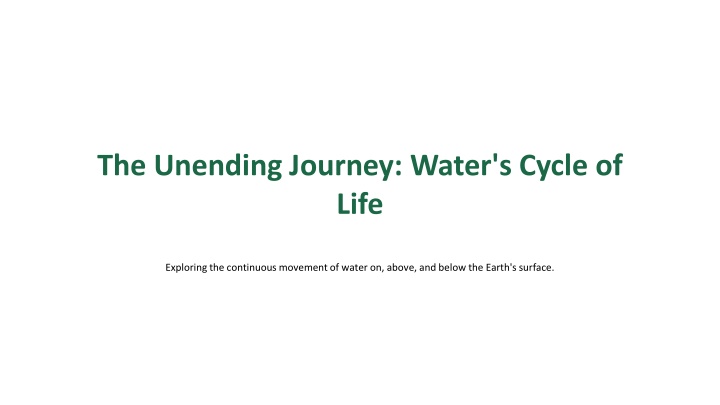
Exploring Water's Continuous Journey: The Unending Cycle
Delve into the fascinating journey of water, from evaporation to precipitation, as it continuously moves on, above, and below the Earth's surface. Discover how solar energy drives evaporation, leading to the formation of clouds and ultimately, precipitation. Explore how water sustains life through the constant cycle of replenishment and movement.
Uploaded on | 3 Views
Download Presentation

Please find below an Image/Link to download the presentation.
The content on the website is provided AS IS for your information and personal use only. It may not be sold, licensed, or shared on other websites without obtaining consent from the author. If you encounter any issues during the download, it is possible that the publisher has removed the file from their server.
You are allowed to download the files provided on this website for personal or commercial use, subject to the condition that they are used lawfully. All files are the property of their respective owners.
The content on the website is provided AS IS for your information and personal use only. It may not be sold, licensed, or shared on other websites without obtaining consent from the author.
E N D
Presentation Transcript
The Unending Journey: Water's Cycle of Life Exploring the continuous movement of water on, above, and below the Earth's surface.
01 A World of Water: The Cycle Begins Table of Contents 02 Evaporation: From Surface to Sky 03 Condensation: Forming the Clouds 04 Precipitation and Collection 05 Thank You
1 A World of Water: The Cycle Begins Solar energy transforms liquid water into vapor, ascending into the atmosphere. This crucial process fuels the entire water cycle. As water vapor rises and cools, it condenses into tiny droplets, forming clouds. The higher the concentration, the darker the cloud. When water droplets in clouds become too heavy, they fall back to Earth as rain, snow, sleet, or hail. The earth is replenished. Precipitation gathers in rivers, lakes, and oceans, and also seeps into the ground as groundwater. This is all part of the continuous cycle. The water cycle is a never-ending journey, constantly repeating these processes. All the phases are connected with each other.
2 Evaporation: From Surface to Sky The sun is the primary driver, providing the energy needed for liquid water to transform into vapor. All thanks to the Sun. Vast bodies of water like oceans and lakes are major sources of evaporation, releasing water into the atmosphere. Plants release water vapor into the atmosphere through transpiration, contributing to the overall evaporation process. The plant helps the cycle. Evaporation increases humidity, the amount of water vapor in the air, setting the stage for condensation. Water absorbs a significant amount of energy during evaporation, playing a crucial role in regulating Earth's temperature.
3 Condensation: Forming the Clouds As water vapor rises, it cools, causing the molecules to slow down and come closer together. It prepares to come down. Water vapor condenses around tiny particles in the air, like dust or pollen, forming cloud droplets. Very tiny particles, so clouds are very high. Different temperatures and atmospheric conditions lead to various cloud formations, from fluffy cumulus to wispy cirrus. Condensation releases heat into the atmosphere, playing a role in weather patterns and atmospheric circulation. Condensation transforms water vapor back into liquid form, a prerequisite for precipitation to occur. Very importantto come down again.
4 Precipitation and Collection When cloud droplets become too heavy, gravity pulls them down to Earth as precipitation. Earth is waiting to gather again. Precipitation occurs in various forms, including rain, snow, sleet, and hail, depending on temperature and atmospheric conditions. Precipitation that flows over the land surface and into rivers, lakes, and oceans is known as surface runoff. Some precipitation seeps into the ground, replenishing groundwater supplies and sustaining ecosystems. This gets deeper. The collected water eventually evaporates, restarting the cycle and ensuring the continuous movement of water.
5 Thank You Thank you for taking the time to learn about the water cycle. We hope this presentation has inspiredyou to explore the wonders of our planet's water systems further. Continue your journey of discovery and learn more about the environment! This is the end of the presentation. We appreciate your support and interest in environmental science. Thank you!
